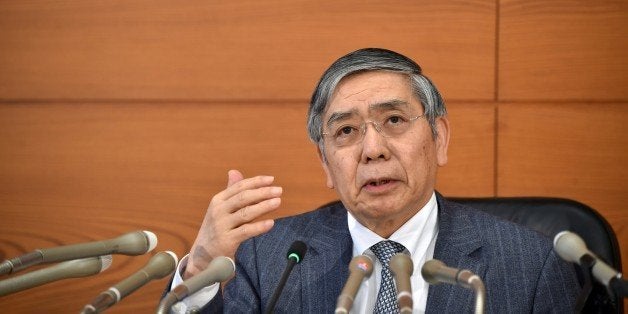
This week the central bank of Japan continues its unprecedented adventures in qualitative and quantitative easing. In the absence of true structural reforms, the burden of boosting Japan's economy has fallen upon the shoulders of Bank of Japan Governor Haruhiko Kuroda. While unconventional monetary policy, including negative interest rates and massive share purchases, has a diminishing chance of closing the gap on the BOJ's two percent inflation goal, there are other measures within his powers that could move Japan's real economy forward. They might just require Gov. Kuroda take on the moniker of Helicopter Kuroda, a nickname first applied to another central banker, Ben Bernanke.
Although Womenomics and immigration have been touted as paths to increased prosperity in Japan, there is something that could be done immediately for an already existing group of 20+ million workers. These are haken, temporary employees, who are hardly temporary; some have worked for the same company for twenty or thirty years. In contrast to permanent employees, haken are permanently disadvantaged in Japanese society on many levels, a factor contributing to Japan's slow-motion demographic crisis. They are precluded for example, from taking out a mortgage. Their numbers have skyrocketed since the financial crisis, and according to Japan's Ministry of Health, Labor & Welfare, all classes of these workers now make up at least half of Japan's entire workforce.
How has this state of affairs been allowed to continue in an egalitarian society such as Japan? One might say that only in Japan would millions of workers put up with second-class status for the entirety of their careers. Permanent employees are well organized, and are not anxious to share their good fortune. They are so entrenched that it has been seriously suggested that it will be necessary for them to die or retire before this changes.
At the same time, Japanese corporations already bloated with cash are about to receive a special bonus from the Bank of Japan. The BOJ is one of the top ten owners of many Japanese company stocks, and currently controls 52 percent of the Japanese ETF market. (Amazingly, the Bank of Japan itself is a listed company on the stock exchange.) Clearly Japanese companies don't know where to invest what they have, so this new infusion of equity will only make the day of reckoning, when the BOJ eventually unwinds its positions, that much more painful.
What could be done with this same amount of money instead? Force these companies to treat temporary and permanent employees equally. Newly empowered employees who are suddenly more secure are likely to spend more. And if the companies refuse and enforcement of new laws continues to be lax, bypass them entirely.
For the BOJ to raise Japan's GDP by say one percent, here are my back of the envelope calculations of the costs of simply writing a check to each of these workers, instead of their employers: Japan's GDP is about 5 trillion dollars, so the target would be to raise GDP by $50B. Discounting for what economists call the marginal propensity to consume of say 65 percent of the money they receive (saving the rest) this would mean that each of the 20 million haken workers would need a check from Mr Kuroda in the amount of $3800. This would cost the government $76 billion of which 35 percent would probably stay in the banking system. And really the BOJ can simply print the money it needs-and isn't inflation what they wanted to achieve anyway?
When all of the obvious solutions have been tried and found wanting, it is time for the less obvious, perhaps the fantastical. This door has already been opened by negative interest rates and massive purchases of listed securities, which have been ineffective. Japan's continued failure to reinvigorate its own economy is highly likely to have spillover effects globally. It is time for real economy creativity, and for painful structural reforms targeted to increase productivity and growth rather than sustain Japan Inc. Some of these measures have been proposed by politicians, but blocked by bureaucrats. What is needed is effective stimulus with long lasting effects, not just for the financial system, but for Japanese society itself.